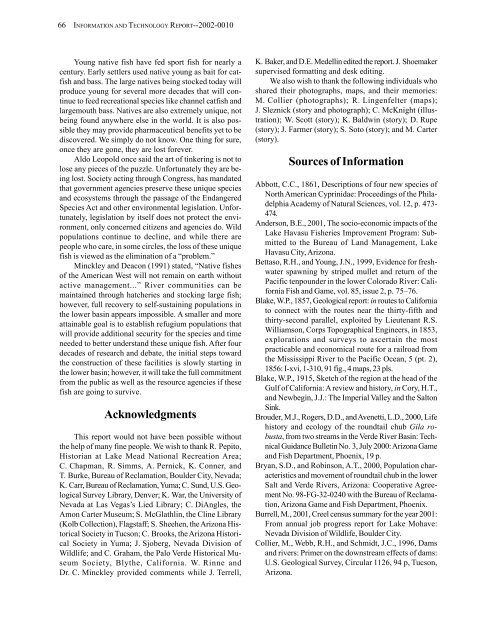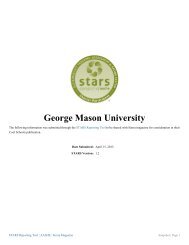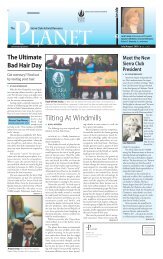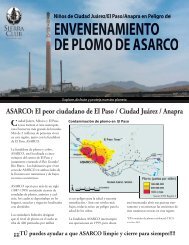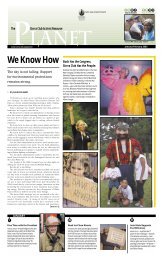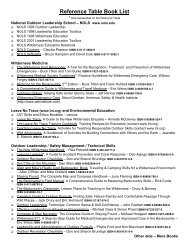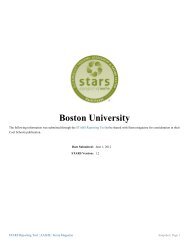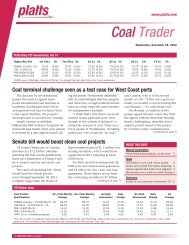Lost, A Desert River and its Native Fishes - Sierra Club
Lost, A Desert River and its Native Fishes - Sierra Club
Lost, A Desert River and its Native Fishes - Sierra Club
Create successful ePaper yourself
Turn your PDF publications into a flip-book with our unique Google optimized e-Paper software.
66 INFORMATION AND TECHNOLOGY REPORT--2002-0010<br />
Young native fish have fed sport fish for nearly a<br />
century. Early settlers used native young as bait for catfish<br />
<strong>and</strong> bass. The large natives being stocked today will<br />
produce young for several more decades that will continue<br />
to feed recreational species like channel catfish <strong>and</strong><br />
largemouth bass. <strong>Native</strong>s are also extremely unique, not<br />
being found anywhere else in the world. It is also possible<br />
they may provide pharmaceutical benef<strong>its</strong> yet to be<br />
discovered. We simply do not know. One thing for sure,<br />
once they are gone, they are lost forever.<br />
Aldo Leopold once said the art of tinkering is not to<br />
lose any pieces of the puzzle. Unfortunately they are being<br />
lost. Society acting through Congress, has m<strong>and</strong>ated<br />
that government agencies preserve these unique species<br />
<strong>and</strong> ecosystems through the passage of the Endangered<br />
Species Act <strong>and</strong> other environmental legislation. Unfortunately,<br />
legislation by <strong>its</strong>elf does not protect the environment,<br />
only concerned citizens <strong>and</strong> agencies do. Wild<br />
populations continue to decline, <strong>and</strong> while there are<br />
people who care, in some circles, the loss of these unique<br />
fish is viewed as the elimination of a —problem.“<br />
Minckley <strong>and</strong> Deacon (1991) stated, —<strong>Native</strong> fishes<br />
of the American West will not remain on earth without<br />
active management...“ <strong>River</strong> communities can be<br />
maintained through hatcheries <strong>and</strong> stocking large fish;<br />
however, full recovery to self-sustaining populations in<br />
the lower basin appears impossible. A smaller <strong>and</strong> more<br />
attainable goal is to establish refugium populations that<br />
will provide additional security for the species <strong>and</strong> time<br />
needed to better underst<strong>and</strong> these unique fish. After four<br />
decades of research <strong>and</strong> debate, the initial steps toward<br />
the construction of these facilities is slowly starting in<br />
the lower basin; however, it will take the full commitment<br />
from the public as well as the resource agencies if these<br />
fish are going to survive.<br />
Acknowledgments<br />
This report would not have been possible without<br />
the help of many fine people. We wish to thank R. Pepito,<br />
Historian at Lake Mead National Recreation Area;<br />
C. Chapman, R. Simms, A. Pernick, K. Conner, <strong>and</strong><br />
T. Burke, Bureau of Reclamation, Boulder City, Nevada;<br />
K. Carr, Bureau of Reclamation, Yuma; C. Sund, U.S. Geological<br />
Survey Library, Denver; K. War, the University of<br />
Nevada at Las Vegas‘s Lied Library; C. DiAngles, the<br />
Amon Carter Museum; S. McGlathlin, the Cline Library<br />
(Kolb Collection), Flagstaff; S. Sheehen, the Arizona Historical<br />
Society in Tucson; C. Brooks, the Arizona Historical<br />
Society in Yuma; J. Sjoberg, Nevada Division of<br />
Wildlife; <strong>and</strong> C. Graham, the Palo Verde Historical Museum<br />
Society, Blythe, California. W. Rinne <strong>and</strong><br />
Dr. C. Minckley provided comments while J. Terrell,<br />
K. Baker, <strong>and</strong> D.E. Medellin edited the report. J. Shoemaker<br />
supervised formatting <strong>and</strong> desk editing.<br />
We also wish to thank the following individuals who<br />
shared their photographs, maps, <strong>and</strong> their memories:<br />
M. Collier (photographs); R. Lingenfelter (maps);<br />
J. Sleznick (story <strong>and</strong> photograph); C. McKnight (illustration);<br />
W. Scott (story); K. Baldwin (story); D. Rupe<br />
(story); J. Farmer (story); S. Soto (story); <strong>and</strong> M. Carter<br />
(story).<br />
Sources of Information<br />
Abbott, C.C., 1861, Descriptions of four new species of<br />
North American Cyprinidae: Proceedings of the Philadelphia<br />
Academy of Natural Sciences, vol. 12, p. 473-<br />
474.<br />
Anderson, B.E., 2001, The socio-economic impacts of the<br />
Lake Havasu Fisheries Improvement Program: Submitted<br />
to the Bureau of L<strong>and</strong> Management, Lake<br />
Havasu City, Arizona.<br />
Bettaso, R.H., <strong>and</strong> Young, J.N., 1999, Evidence for freshwater<br />
spawning by striped mullet <strong>and</strong> return of the<br />
Pacific tenpounder in the lower Colorado <strong>River</strong>: California<br />
Fish <strong>and</strong> Game, vol. 85, issue 2, p. 75œ76.<br />
Blake, W.P., 1857, Geological report: in routes to California<br />
to connect with the routes near the thirty-fifth <strong>and</strong><br />
thirty-second parallel, exploited by Lieutenant R.S.<br />
Williamson, Corps Topographical Engineers, in 1853,<br />
explorations <strong>and</strong> surveys to ascertain the most<br />
practicable <strong>and</strong> economical route for a railroad from<br />
the Mississippi <strong>River</strong> to the Pacific Ocean, 5 (pt. 2),<br />
1856: I-xvi, 1-310, 91 fig., 4 maps, 23 pls.<br />
Blake, W.P., 1915, Sketch of the region at the head of the<br />
Gulf of California: A review <strong>and</strong> history, in Cory, H.T.,<br />
<strong>and</strong> Newbegin, J.J.: The Imperial Valley <strong>and</strong> the Salton<br />
Sink.<br />
Brouder, M.J., Rogers, D.D., <strong>and</strong> Avenetti, L.D., 2000, Life<br />
history <strong>and</strong> ecology of the roundtail chub Gila robusta,<br />
from two streams in the Verde <strong>River</strong> Basin: Technical<br />
Guidance Bulletin No. 3, July 2000: Arizona Game<br />
<strong>and</strong> Fish Department, Phoenix, 19 p.<br />
Bryan, S.D., <strong>and</strong> Robinson, A.T., 2000, Population characteristics<br />
<strong>and</strong> movement of roundtail chub in the lower<br />
Salt <strong>and</strong> Verde <strong>River</strong>s, Arizona: Cooperative Agreement<br />
No. 98-FG-32-0240 with the Bureau of Reclamation,<br />
Arizona Game <strong>and</strong> Fish Department, Phoenix.<br />
Burrell, M., 2001, Creel census summary for the year 2001:<br />
From annual job progress report for Lake Mohave:<br />
Nevada Division of Wildlife, Boulder City.<br />
Collier, M., Webb, R.H., <strong>and</strong> Schmidt, J.C., 1996, Dams<br />
<strong>and</strong> rivers: Primer on the downstream effects of dams:<br />
U.S. Geological Survey, Circular 1126, 94 p, Tucson,<br />
Arizona.


